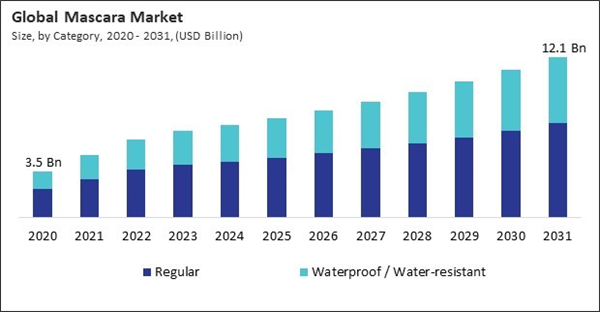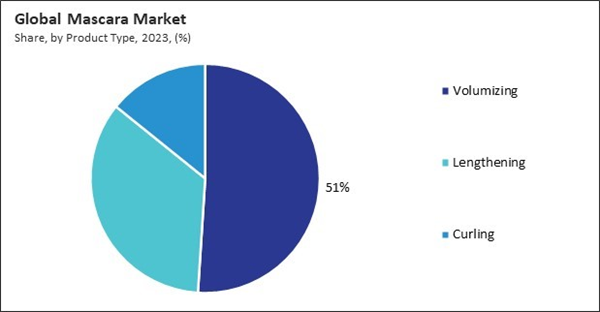Europe is known for its strong emphasis on beauty, fashion, and personal grooming. Consumers in France, Italy, the UK, and Germany value high-quality cosmetic products, including mascara, as essential components of their daily beauty routines and self-expression. Consequently, the Europe region would acquire nearly 27% of the total market share by 2031. Additionally, the Russian E-commerce channels would register a volume of 22.39 Million Units (6-12ML) by 2031. European consumers are influenced by global beauty trends as well as regional preferences.
There has been a notable shift in beauty trends towards emphasizing eye makeup. Influenced by celebrities, influencers, and runway looks, trends such as smoky eyes, winged eyeliner, and bold lashes have become mainstream. In addition, makeup, including eye makeup, is increasingly seen as a form of self-expression. Therefore, increasing focus on eye makeup is driving the market's growth. Additionally, E-commerce platforms enable mascara brands to reach a global audience beyond traditional geographical boundaries. Furthermore, e-commerce platforms showcase various mascara products, including different formulations (waterproof, volumizing, lengthening, etc.), shades, and brands. In conclusion, the expansion of the e-commerce sector is driving the market's growth.
However, like many other cosmetics, mascara typically has a recommended shelf life of three to six months after opening. Moreover, the short lifespan can also affect consumers’ perception of value for money. If a mascara dries out or expires before it is fully used, consumers may feel they did not receive adequate value for their purchase. Thus, the short product lifespan is hampering the growth of the market.
Driving and Restraining Factors
Drivers- Increasing focus on eye makeup
- Expansion of the e-commerce sector
- Expansion of the cosmetics and personal care industry
- Short product lifespan
- Allergies and sensitivities to ingredients
- Influence of social media and beauty influencers
- Increasing female workforce globally
- Competition from eyelash extensions and false lashes
- Concerns over microplastic pollution
Category Outlook
Based on category, the mascara market is bifurcated into regular and waterproof or water-resistant. The waterproof or water-resistant segment attained a 40% revenue share in the mascara market in 2023. In terms of volume, the segment recorded 228.48 Million Units (6-12ML) in 2023. Waterproof mascaras are designed to resist water, humidity, sweat, and tears better than regular mascaras. This durability ensures that the mascara remains intact and smudge-proof throughout the day.Product Type Outlook
On the basis of product type, the mascara market is segmented into volumizing, lengthening, and curling. In 2023, the lengthening segment attained 34.7% revenue share in the mascara market. Lengthening mascaras are designed to elongate and extend lashes, creating a natural-looking effect that emphasizes eye shape and enhances overall eye appearance. Consumers appreciate the subtle yet noticeable enhancement of lengthening mascaras, making them suitable for everyday wear.Distribution Channel Outlook
By distribution channel, the mascara market is divided into offline channels and e-commerce. The e-commerce segment procured a 42% revenue share in the mascara market in 2023. In terms of volume, the e-commerce segment recorded 281.47 Million Units (6-12ML) in 2023. E-commerce platforms provide unmatched convenience, allowing consumers to browse, compare, and purchase mascara products conveniently from home or on the move using mobile devices.Regional Outlook
Region-wise, the mascara market is analyzed across North America, Europe, Asia Pacific, and LAMEA. The Asia Pacific region witnessed 36.4% revenue share in the mascara market in 2023. The region has a large and youthful population, particularly in countries like India, Indonesia, and the Philippines. Young consumers are actively engaged in beauty trends and social media platforms, where makeup tutorials, beauty influencers, and product recommendations drive mascara purchases.List of Key Companies Profiled
- Chanel S.A.
- The Procter and Gamble Company
- Coty, Inc.
- Shiseido Company Limited
- Revlon, Inc. (MacAndrews & Forbes)
- The Estee Lauder Companies, Inc.
- L'Oreal S.A.
- Avon Products, Inc. (Natura &Co Holding S.A.)
- KOSE Corporation
- Mary Kay Inc.
Market Report Segmentation
By Category (Volume, Million Units (6-12ML), USD Billion, 2020-2031)- Regular
- Waterproof / Water-resistant
- Volumizing
- Lengthening
- Curling
- Offline Channel
- E-Commerce
- North America
- US
- Canada
- Mexico
- Rest of North America
- Europe
- Germany
- UK
- France
- Russia
- Spain
- Italy
- Rest of Europe
- Asia Pacific
- China
- Japan
- India
- South Korea
- Singapore
- Malaysia
- Rest of Asia Pacific
- LAMEA
- Brazil
- Argentina
- UAE
- Saudi Arabia
- South Africa
- Nigeria
- Rest of LAMEA
Table of Contents
Companies Mentioned
- Chanel S.A.
- The Procter and Gamble Company
- Coty, Inc.
- Shiseido Company Limited
- Revlon, Inc. (MacAndrews & Forbes)
- The Estee Lauder Companies, Inc.
- L'Oreal S.A.
- Avon Products, Inc. (Natura &Co Holding S.A.)
- KOSE Corporation
- Mary Kay Inc.










